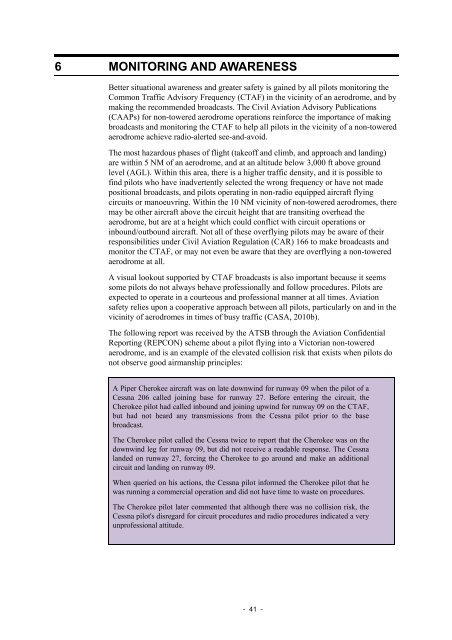Safety in the vicinity of non-towered aerodromes - Australian ...
Safety in the vicinity of non-towered aerodromes - Australian ...
Safety in the vicinity of non-towered aerodromes - Australian ...
You also want an ePaper? Increase the reach of your titles
YUMPU automatically turns print PDFs into web optimized ePapers that Google loves.
6 MONITORING AND AWARENESS<br />
Better situational awareness and greater safety is ga<strong>in</strong>ed by all pilots monitor<strong>in</strong>g <strong>the</strong><br />
Common Traffic Advisory Frequency (CTAF) <strong>in</strong> <strong>the</strong> vic<strong>in</strong>ity <strong>of</strong> an aerodrome, and by<br />
mak<strong>in</strong>g <strong>the</strong> recommended broadcasts. The Civil Aviation Advisory Publications<br />
(CAAPs) for <strong>non</strong>-<strong>towered</strong> aerodrome operations re<strong>in</strong>force <strong>the</strong> importance <strong>of</strong> mak<strong>in</strong>g<br />
broadcasts and monitor<strong>in</strong>g <strong>the</strong> CTAF to help all pilots <strong>in</strong> <strong>the</strong> vic<strong>in</strong>ity <strong>of</strong> a <strong>non</strong>-<strong>towered</strong><br />
aerodrome achieve radio-alerted see-and-avoid.<br />
The most hazardous phases <strong>of</strong> flight (take<strong>of</strong>f and climb, and approach and land<strong>in</strong>g)<br />
are with<strong>in</strong> 5 NM <strong>of</strong> an aerodrome, and at an altitude below 3,000 ft above ground<br />
level (AGL). With<strong>in</strong> this area, <strong>the</strong>re is a higher traffic density, and it is possible to<br />
f<strong>in</strong>d pilots who have <strong>in</strong>advertently selected <strong>the</strong> wrong frequency or have not made<br />
positional broadcasts, and pilots operat<strong>in</strong>g <strong>in</strong> <strong>non</strong>-radio equipped aircraft fly<strong>in</strong>g<br />
circuits or manoeuvr<strong>in</strong>g. With<strong>in</strong> <strong>the</strong> 10 NM vic<strong>in</strong>ity <strong>of</strong> <strong>non</strong>-<strong>towered</strong> <strong>aerodromes</strong>, <strong>the</strong>re<br />
may be o<strong>the</strong>r aircraft above <strong>the</strong> circuit height that are transit<strong>in</strong>g overhead <strong>the</strong><br />
aerodrome, but are at a height which could conflict with circuit operations or<br />
<strong>in</strong>bound/outbound aircraft. Not all <strong>of</strong> <strong>the</strong>se overfly<strong>in</strong>g pilots may be aware <strong>of</strong> <strong>the</strong>ir<br />
responsibilities under Civil Aviation Regulation (CAR) 166 to make broadcasts and<br />
monitor <strong>the</strong> CTAF, or may not even be aware that <strong>the</strong>y are overfly<strong>in</strong>g a <strong>non</strong>-<strong>towered</strong><br />
aerodrome at all.<br />
A visual lookout supported by CTAF broadcasts is also important because it seems<br />
some pilots do not always behave pr<strong>of</strong>essionally and follow procedures. Pilots are<br />
expected to operate <strong>in</strong> a courteous and pr<strong>of</strong>essional manner at all times. Aviation<br />
safety relies upon a cooperative approach between all pilots, particularly on and <strong>in</strong> <strong>the</strong><br />
vic<strong>in</strong>ity <strong>of</strong> <strong>aerodromes</strong> <strong>in</strong> times <strong>of</strong> busy traffic (CASA, 2010b).<br />
The follow<strong>in</strong>g report was received by <strong>the</strong> ATSB through <strong>the</strong> Aviation Confidential<br />
Report<strong>in</strong>g (REPCON) scheme about a pilot fly<strong>in</strong>g <strong>in</strong>to a Victorian <strong>non</strong>-<strong>towered</strong><br />
aerodrome, and is an example <strong>of</strong> <strong>the</strong> elevated collision risk that exists when pilots do<br />
not observe good airmanship pr<strong>in</strong>ciples:<br />
A Piper Cherokee aircraft was on late downw<strong>in</strong>d for runway 09 when <strong>the</strong> pilot <strong>of</strong> a<br />
Cessna 206 called jo<strong>in</strong><strong>in</strong>g base for runway 27. Before enter<strong>in</strong>g <strong>the</strong> circuit, <strong>the</strong><br />
Cherokee pilot had called <strong>in</strong>bound and jo<strong>in</strong><strong>in</strong>g upw<strong>in</strong>d for runway 09 on <strong>the</strong> CTAF,<br />
but had not heard any transmissions from <strong>the</strong> Cessna pilot prior to <strong>the</strong> base<br />
broadcast.<br />
The Cherokee pilot called <strong>the</strong> Cessna twice to report that <strong>the</strong> Cherokee was on <strong>the</strong><br />
downw<strong>in</strong>d leg for runway 09, but did not receive a readable response. The Cessna<br />
landed on runway 27, forc<strong>in</strong>g <strong>the</strong> Cherokee to go around and make an additional<br />
circuit and land<strong>in</strong>g on runway 09.<br />
When queried on his actions, <strong>the</strong> Cessna pilot <strong>in</strong>formed <strong>the</strong> Cherokee pilot that he<br />
was runn<strong>in</strong>g a commercial operation and did not have time to waste on procedures.<br />
The Cherokee pilot later commented that although <strong>the</strong>re was no collision risk, <strong>the</strong><br />
Cessna pilot's disregard for circuit procedures and radio procedures <strong>in</strong>dicated a very<br />
unpr<strong>of</strong>essional attitude.<br />
- 41 -
















